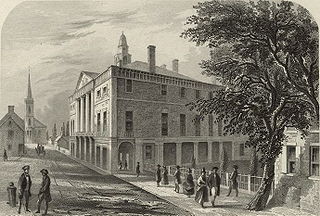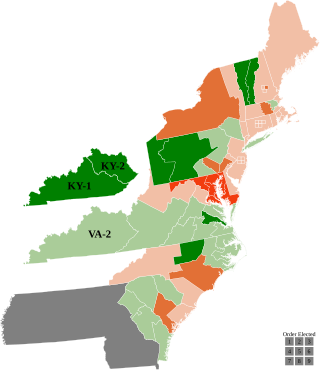
The 1st United States Congress, comprising the United States Senate and the United States House of Representatives, met from March 4, 1789, to March 4, 1791, during the first two years of George Washington's presidency, first at Federal Hall in New York City and later at Congress Hall in Philadelphia. With the initial meeting of the First Congress, the United States federal government officially began operations under the new frame of government established by the 1787 Constitution. The apportionment of seats in the House of Representatives was based on the provisions of Article I, Section 2, Clause 3, of the Constitution. Both chambers had a Pro-Administration majority. Twelve articles of amendment to the Constitution were passed by this Congress and sent to the states for ratification; the ten ratified as additions to the Constitution on December 15, 1791, are collectively known as the Bill of Rights, with an additional amendment ratified more than two centuries later to become the Twenty-seventh Amendment to the United States Constitution.

The 2nd United States Congress, consisting of the United States Senate and the United States House of Representatives, met at Congress Hall in Philadelphia, Pennsylvania, from March 4, 1791, to March 4, 1793, during the third and fourth years of George Washington's presidency. The apportionment of seats in the House of Representatives was based on the provisions of Article I, Section 2, Clause 3 of the United States Constitution. Additional House seats were assigned to the two new states of Vermont and Kentucky. Both chambers had a Pro-Administration majority.

Roger Sherman was an early American statesman, lawyer, and a Founding Father of the United States. He is the only person to sign all four great state papers of the United States: the Continental Association, the Declaration of Independence, the Articles of Confederation, and the Constitution. He also signed the 1774 Petition to the King.

The 1790–91 United States House of Representatives elections were held on various dates in various states between April 27, 1790, and October 11, 1791. Each state set its own date for its elections to the House of Representatives before or after the first session of the 2nd United States Congress convened on October 24, 1791. This was the first midterm election cycle, which took place in the middle of President George Washington's first term. The size of the House increased to 67 seats after the new state of Vermont elected its first representatives.

The 1788–89 United States House of Representatives elections were the first U.S. House of Representatives elections following the adoption of the Constitution of the United States. Each state set its own date for its congressional elections, ranging from November 24, 1788, to March 5, 1789, before or after the first session of the 1st United States Congress convened on March 4, 1789. They coincided with the election of George Washington as the first president of the United States.
The presiding officer of the United States Senate is the person who presides over the United States Senate and is charged with maintaining order and decorum, recognizing members to speak, and interpreting the Senate's rules, practices, and precedents. Senate presiding officer is a role, not an actual office. The actual role is usually performed by one of three officials: the vice president of the United States; an elected United States senator; or, under certain circumstances, the chief justice of the United States. Outside the constitutionally mandated roles, the actual appointment of a person to do the job of presiding over the Senate as a body is governed by Rule I of the Standing Rules.

The 1790–91 United States Senate elections were held on various dates in various states. These U.S. Senate elections occurred during the first midterm election cycle, which took place in the middle of President George Washington's first term. As these elections were prior to the ratification of the Seventeenth Amendment in 1913, senators were chosen by state legislatures. Senators were elected over a wide range of time throughout 1790 and 1791, and a seat may have been filled months late or remained vacant due to legislative deadlock. In these elections, terms were up for the nine senators in Class 1.

The 1792–93 United States Senate elections were held on various dates in various states, coinciding with President George Washington's unanimous re-election. As these U.S. Senate elections were prior to the ratification of the Seventeenth Amendment in 1913, senators were chosen by state legislatures. Senators were elected over a wide range of time throughout 1792 and 1793, and a seat may have been filled months late or remained vacant due to legislative deadlock. In these elections, terms were up for the ten senators in Class 2.

The 1789 United States House of Representatives elections in New York were held on March 3 and 4, 1789, to elect 6 U.S. Representatives to represent the State of New York in the 1st United States Congress.

The 1790 United States House of Representatives elections in New York were held from April 27 to 29, 1790, to elect six U.S. Representatives to represent the State of New York in the United States House of Representatives.

The 1793 United States House of Representatives elections in New York were held in January 1793, to elect 10 U.S. Representatives to represent the State of New York in the United States House of Representatives.

The 1788–1789 United States Senate elections were the first U.S. Senate elections following the adoption of the Constitution of the United States. They coincided with the election of George Washington as the first president of the United States. As these elections were prior to the ratification of the Seventeenth Amendment in 1913, senators were chosen by state legislatures.

Connecticut elected all five of its representatives at-large on a general ticket on September 20, 1790.
Elections for the United States House of Representatives for the 2nd Congress were held in Massachusetts beginning October 4, 1790, with subsequent elections held in four districts due to a majority not being achieved on the first ballot.
Elections to the United States House of Representatives were held in Pennsylvania on Tuesday, October 11, 1791, for the 2nd Congress.

John Sherman was an American politician from Ohio who served in federal office throughout the Civil War and into the late nineteenth century. A member of the Republican Party, he served in both houses of the U.S. Congress. He also served as Secretary of the Treasury and Secretary of State. Sherman sought the Republican presidential nomination three times, coming closest in 1888, but was never chosen by the party.
Sherman Adams Packard is an American politician in the state of New Hampshire. He is the speaker of the New Hampshire House of Representatives, sitting as a Republican from the Rockingham 5 district, having been first elected in 1990.










